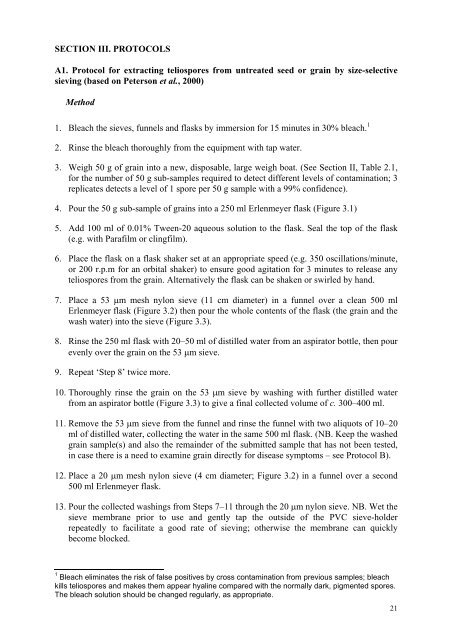Tilletia indica - The Food and Environment Research Agency - Defra
Tilletia indica - The Food and Environment Research Agency - Defra
Tilletia indica - The Food and Environment Research Agency - Defra
You also want an ePaper? Increase the reach of your titles
YUMPU automatically turns print PDFs into web optimized ePapers that Google loves.
SECTION III. PROTOCOLS<br />
A1. Protocol for extracting teliospores from untreated seed or grain by size-selective<br />
sieving (based on Peterson et al., 2000)<br />
Method<br />
1. Bleach the sieves, funnels <strong>and</strong> flasks by immersion for 15 minutes in 30% bleach. 1<br />
2. Rinse the bleach thoroughly from the equipment with tap water.<br />
3. Weigh 50 g of grain into a new, disposable, large weigh boat. (See Section II, Table 2.1,<br />
for the number of 50 g sub-samples required to detect different levels of contamination; 3<br />
replicates detects a level of 1 spore per 50 g sample with a 99% confidence).<br />
4. Pour the 50 g sub-sample of grains into a 250 ml Erlenmeyer flask (Figure 3.1)<br />
5. Add 100 ml of 0.01% Tween-20 aqueous solution to the flask. Seal the top of the flask<br />
(e.g. with Parafilm or clingfilm).<br />
6. Place the flask on a flask shaker set at an appropriate speed (e.g. 350 oscillations/minute,<br />
or 200 r.p.m for an orbital shaker) to ensure good agitation for 3 minutes to release any<br />
teliospores from the grain. Alternatively the flask can be shaken or swirled by h<strong>and</strong>.<br />
7. Place a 53 µm mesh nylon sieve (11 cm diameter) in a funnel over a clean 500 ml<br />
Erlenmeyer flask (Figure 3.2) then pour the whole contents of the flask (the grain <strong>and</strong> the<br />
wash water) into the sieve (Figure 3.3).<br />
8. Rinse the 250 ml flask with 20–50 ml of distilled water from an aspirator bottle, then pour<br />
evenly over the grain on the 53 µm sieve.<br />
9. Repeat ‘Step 8’ twice more.<br />
10. Thoroughly rinse the grain on the 53 µm sieve by washing with further distilled water<br />
from an aspirator bottle (Figure 3.3) to give a final collected volume of c. 300–400 ml.<br />
11. Remove the 53 µm sieve from the funnel <strong>and</strong> rinse the funnel with two aliquots of 10–20<br />
ml of distilled water, collecting the water in the same 500 ml flask. (NB. Keep the washed<br />
grain sample(s) <strong>and</strong> also the remainder of the submitted sample that has not been tested,<br />
in case there is a need to examine grain directly for disease symptoms – see Protocol B).<br />
12. Place a 20 µm mesh nylon sieve (4 cm diameter; Figure 3.2) in a funnel over a second<br />
500 ml Erlenmeyer flask.<br />
13. Pour the collected washings from Steps 7–11 through the 20 µm nylon sieve. NB. Wet the<br />
sieve membrane prior to use <strong>and</strong> gently tap the outside of the PVC sieve-holder<br />
repeatedly to facilitate a good rate of sieving; otherwise the membrane can quickly<br />
become blocked.<br />
1 Bleach eliminates the risk of false positives by cross contamination from previous samples; bleach<br />
kills teliospores <strong>and</strong> makes them appear hyaline compared with the normally dark, pigmented spores.<br />
<strong>The</strong> bleach solution should be changed regularly, as appropriate.<br />
21

















